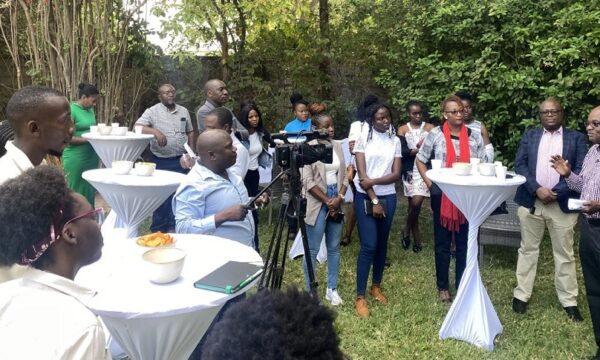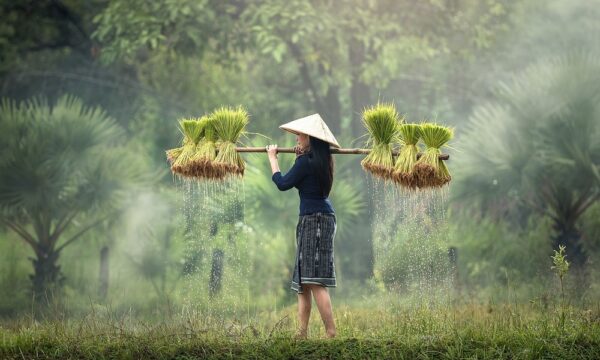
The climate crisis does not affect everyone equally. Women and girls are more likely to experience the greatest impacts of climate change. According to the UN Environment Programme, for example, 80% of people displaced by climate change are women. And in an article from 2022, the UN Entity for Gender Equality and the Empowerment of Women explained how climate change amplifies existing gender inequalities and poses unique threats to the livelihoods, health and safety of women and girls.
This follows a trend where women and girls are deprioritised in the wake of natural disasters and more likely to face life and death situations. A 2021 World Bank study found that women’s mortality from disasters tends to be higher than that of men in countries where women have lower socioeconomic status. The climate crisis exacerbates this trend and means we must give the link between climate change and gender much more attention.
Women’s work often relies on natural resources
Most of the world’s poorest people are women. When it comes to food security, they often carry a bigger load for ensuring that households have enough to eat. And when it comes to households’ fuel and water, they take a disproportionate burden here, too. The daily search for resources is labour-intensive and time-consuming. They rely on nature for their families’ survival, but nature is under threat from global warming. The issues of gender equity and climate change are becoming increasingly intertwined.

In low- and lower-middle-income countries, agriculture is the biggest employment sector for women and youth. But during periods of unpredictable weather, farming employment becomes unpredictable, too. When work is scarce, young women and girls are often the first to be taken out of school to help their mothers increase scant income.
A number of conditions must be met for people to adapt to climate change and build resilience. This includes, for example, access to adequate information and resources. And gender plays a role as to whether the conditions will be met. Women traditionally have less access, control and ownership over resources, for example. They also have less access to climate adaptation knowledge and information. Many things disadvantage women from lack of decision-making power to social status whether that be in the family or in the community. And this affects women’s ability to adapt to the impacts of climate change.
Women bring unique insights to climate adaptation and mitigation

However, women have unique insights into the need for climate adaptation and resilience. Their voices must be heard. Women are not sufficiently recognized for their potential role in addressing the climate crisis. And this lack of recognition could undermine global efforts to address the link between climate change and gender.
Working in rural environments, women are often the first to notice when an ecosystem is breaking down. As the ones who gather fuel and water, they will often be the first to notice when resources are depleted. They are frequently the first to find coping mechanisms for the effects of extreme weather conditions. We need a distinct focus on women’s constraints, needs and priorities. But we must also listen to their specific insights, knowledge and local strategies.
How can we address climate change and gender equity?
To address these inequalities, we must take action. In international development projects, we need to think about how we design climate adaptation programmes. During the design of projects, cultural sensitivity should be kept in mind, alongside workable strategies that are inclusive. Our actions must be responsive to the many roles women and men play in different spheres of life. This includes everything from household management to natural resource management. More broadly, it means working towards gender equality into home, work and community life.
Women need more access to resources

Development programmes and projects should have a strong focus on gender equity. This will ensure that adequate resources are allocated to women and youth. Without this, we will be unable to translate vision into tangible reality. A critical element of equity is safeguarding women’s access, control and ownership of resources. This includes land, livestock, property and income-generating opportunities. And we must strengthen access to development resources such as credit, information, outreach and entrepreneurial skills and training.
Most of all, the women themselves must be involved in the equality process. We must design and implement investments to reflect their concerns and needs. Furthermore, many women do not have access to basic information about climate adaptation. Investing in awareness raising campaigns about climate change at the grassroots level can combat that.
Women need technologies to save labour and time
Labour-saving technology can play a significant role in women’s equality. Investing in gender-sensitive green technologies can help women and girls in rural communities to save time. Water harvesting and storage technologies can be hugely beneficial, and irrigation systems, too. Since women are often the ones who must look for wood for fuel, energy substitutes can also massively speed up labour.
We need more insights into climate change and gender inequity
The scope of gender-based work is broad and diverse. It encompasses many elements, from cultural to economic to social. The environments in which the transformation must take place are equally diverse. They range from agricultural land to forests, pastures and watersheds. They include situations from small households to broad communities.
This range means we must deepen our knowledge of the status with research and systematic analysis. We urgently need to fill in gaps in data and knowledge about the impact of climate change on women and youth. We must go deeper into the data. This means understanding the differences among women in more detail. What do we know about their age, caste, class, marital status and profession? Do we know enough about the cultural set-up and traditions? Are these differences well enough understood concerning the impact of climate change?

By increasing women’s voices in households and communities, the connection between climate change and gender can be better addressed. This is because participation and agency help women become part of climate adaptation decisions. Substantive inputs by women in decision- and policymaking can make a real difference. In local, national, regional and international institutions, it can help. Education and training can address women’s vulnerability and bring lasting benefits and change.
We must make gender and social inclusion a central feature of all development projects. Through our medium-term strategy, CABI has made climate change and gender two central pillars of its work. We aim to empower women with skills, tools and knowledge to adapt to the impacts of climate. ‘Gender’ has become a lens through which we consider all projects and programmes, especially those addressing climate change.
About the author: Sajila Khan is the Gender Coordinator for Asia, based at CABI’s centre in Pakistan. Learn more about Sajila in this Q&A.
Read more
A One Health Social Science Approach to Water Security and Gender Equity in Rural Uganda
“Through the gender lens, invisible women farmers can finally be seen”
How can we help smallholders build resilience to climate change?
Women are not just farmers’ wives: overcoming stereotypes of women in agriculture
Social norms: why women farmers might not be getting ahead despite development support
Do invasive species impact men and women differently?
All images are ©CABI
2 Comments
Leave a Reply
Related News & Blogs
On Earth Day, we take a look at climate change and agriculture
Climate change poses a threat to the livelihoods of smallholder farmers, exacerbating existing risks like extreme weather and the migration of crop pests and diseases that threaten food security. Already, the climate crisis is accelerating biodiversity…
22 April 2024





This recently published CABI One Health Case Study reveals a prime example of what Kajila Khan is saying in this blog post.
Nankanja, A. et al. (2023) ‘A One Health Social Science Approach to Water Security and Gender Equity in Rural Uganda’, One Health Cases. CABI. doi: 10.1079/onehealthcases.2023.0026.
Hi Cheryl, thank you for flagging this one. I’ve added it to the read more list in the article.